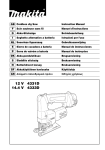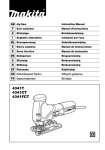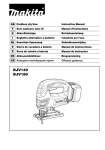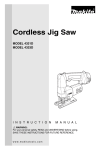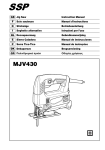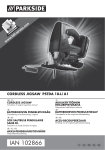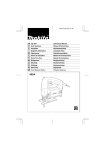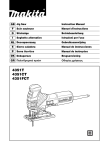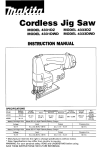Download Makita 4333D Instruction manual
Transcript
GB Cordless Jig Saw Instruction Manual F Scie sauteuse sans fil Manuel d’instructions D Akku-Stichsäge Betriebsanleitung I Seghetto alternativo a batteria Istruzioni per l’uso NL Snoerloze figuurzaag Gebruiksaanwijzing E Sierra de cacadora a batería Manual de instrucciones P Serra de vaivém a bateria Manual de instruções DK Akku-pendulstiksav Brugsanvisning S Sladdlös sticksåg Bruksanvisning N Batteridrevet løvsag Bruksanvisning SF Akkukäyttöinen kuviosaha Käyttöohje GR Ασύρµατο παλινδροµικ πρινι Οδηγίες χρήσεως 12 V 14.4 V 4331D 4333D 1 3 4 5 2 1 2 6.35 mm 6 7 5 3 4 8 5 9 5 6 10 11 12 7 2 13 14 8 17 4 15 16 9 13 18 10 19 11 12 13 14 5 21 4 13 20 15 16 3 23 4 24 15 25 22 17 18 28 26 13 27 13 19 20 28 29 21 22 30 31 23 4 ENGLISH Explanation of general view 1 2 3 4 5 6 7 8 9 Button Battery cartridge Loosen Hex wrench Bolt Jig saw blade Roller The end of the blade shank should reach the bottom of the inner slit. Lever 10 11 12 13 14 15 16 17 18 19 20 Speed adjusting dial Lock-off button Switch trigger Base Cutting line Bolt Cross-shaped slot Edge of motor housing Graduations Starting hole Anti-splintering device 21 22 23 24 25 26 27 28 29 30 31 Plastic base plate Guide rule Threaded knob Circular guide Pin Fit into notches. Plastic cover Nozzle Limit mark Screwdriver Brush holder cap SPECIFICATIONS Model 4331D Length of stroke ........................................................................... 26 mm Max. cutting capacities Wood ........................................................................................ 65 mm Mild steel .................................................................................. 10 mm Aluminum .................................................................................. 20 mm Strokes per minute ...................................................................... 500 – 2,800 Overall length .............................................................................. 280 mm Net weight .................................................................................... 2.6 kg Rated voltage .............................................................................. D.C. 12 V • Due to our continuing program of research and development, the specifications herein are subject to change without notice. • Note: Specifications may differ from country to country. 6. Intended use The tool is intended for the sawing of wood, plastic and metal materials. As a result of the extensive accessory and saw blade program, the tool can be used for many purposes and is very well suited for curved or circular cuts. Safety hints For your own safety, please refer to the enclosed safety instructions. IMPORTANT SAFETY INSTRUCTIONS FOR CHARGER & BATTERY CARTRIDGE ENC004-1 1. 2. 3. 4. 5. Before using battery cartridge, read all instructions and cautionary markings on (1) battery charger, (2) battery, and (3) product using battery. Do not disassemble battery cartridge. If operating time has become excessively shorter, stop operating immediately. It may result in a risk of overheating, possible burns and even an explosion. If electrolyte gets into your eyes, rinse them out with clear water and seek medical attention right away. It may result in loss of your eyesight. Always cover the battery terminals with the battery cover when the battery cartridge is not used. 7. 8. 9. 4333D 26 mm 65 mm 10 mm 20 mm 500 – 2,600 280 mm 2.9 kg D.C. 14.4 V Do not short the battery cartridge: (1) Do not touch the terminals with any conductive material. (2) Avoid storing battery cartridge in a container with other metal objects such as nails, coins, etc. (3) Do not expose battery cartridge to water or rain. A battery short can cause a large current flow, overheating, possible burns and even a breakdown. Do not store the tool and battery cartridge in locations where the temperature may reach or exceed 50°C (122°F). Do not incinerate the battery cartridge even if it is severely damaged or is completely worn out. The battery cartridge can explode in a fire. Be careful not to drop or strike battery. SAVE THESE INSTRUCTIONS. Tips for maintaining maximum battery life 1. 2. 3. 4. Charge the battery cartridge before completely discharged. Always stop tool operation and charge the battery cartridge when you notice less tool power. Never recharge a fully charged battery cartridge. Overcharging shortens the battery service life. Charge the battery cartridge with room temperature at 10°C – 40°C (50°F – 104°F). Let a hot battery cartridge cool down before charging it. Charge the Nickel Metal Hydride battery cartridge when you do not use it for more than six months. 5 SPECIFIC SAFETY RULES 8. GEB016-1 DO NOT let comfort or familiarity with product (gained from repeated use) replace strict adherence to jig saw safety rules. If you use this tool unsafely or incorrectly, you can suffer serious personal injury. 1. Hold power tools by insulated gripping surfaces when performing an operation where the cutting tool may contact hidden wiring or its own cord. Contact with a "live" wire will make exposed metal parts of the tool "live" and shock the operator. 2. 4. 5. 6. 7. 11. 12. 13. 14. Use clamps or another practical way to secure and support the workpiece to a stable platform. Holding the work by hand or against your body leaves it unstable and may lead to loss of control. 3. 9. 10. Always use safety glasses or goggles. Ordinary eye or sun glasses are NOT safety glasses. Avoid cutting nails. Inspect workpiece for any nails and remove them before operation. Do not cut oversize workpiece. Check for the proper clearance beyond the workpiece before cutting so that the blade will not strike the floor, workbench, etc. Hold the tool firmly. 15. Make sure the blade is not contacting the workpiece before the switch is turned on. Keep hands away from moving parts. Do not leave the tool running. Operate the tool only when hand-held. Always switch off and wait for the blade to come to a complete stop before removing the blade from the workpiece. Do not touch the blade or the workpiece immediately after operation; they may be extremely hot and could burn your skin. Do not operate the tool at no-load unnecessarily. Some material contains chemicals which may be toxic. Take caution to prevent dust inhalation and skin contact. Follow material supplier safety data. Always use the correct dust mask/respirator for the material and application you are working with. SAVE THESE INSTRUCTIONS. WARNING: MISUSE or failure to follow the safety rules stated in this instruction manual may cause serious personal injury. OPERATING INSTRUCTIONS Installing or removing battery cartridge (Fig. 1) • Always switch off the tool before insertion or removal of the battery cartridge. • To remove the battery cartridge, withdraw it from the tool while pressing the buttons on both sides of the cartridge. • To insert the battery cartridge, align the tongue on the battery cartridge with the groove in the housing and slip it into place. Always insert it all the way until it locks in place with a little click. If not, it may accidentally fall out of the tool, causing injury to you or someone around you. • Do not use force when inserting the battery cartridge. If the cartridge does not slide in easily, it is not being inserted correctly. Installing or removing saw blade (Fig. 2 & 3) CAUTION: • Always be sure that the tool is switched off and unplugged before installing or removing the blade. • Always clean out all chips or foreign matter adhering to the blade and/or blade holder. Failure to do so may cause insufficient tightening of the blade, resulting in a serious injury. • Use a lubricant or cutting oil between the blade and roller when cutting iron or composition board, etc. Failure to do so will shorten the service life of your blade and roller or lead to potentially dangerous blade breakage. To install the blade, loosen the bolt on the blade holder with the hex wrench. With the blade teeth facing forward, insert the blade into the blade holder as far as it will go. Make sure that the back edge of the blade fits into the roller. Then tighten the bolt to secure the blade. To remove the blade, follow the installation procedures in reverse. NOTE: Occasionally lubricate the roller. Installing universal shank jig saw blade (Fig. 4 & 5) CAUTION: Always be sure that the tool is switched off and unplugged before installing or removing the blade. If the universal blade clamp is used, you can use blades of other makes which have a universal shank like the one shown in the figure, with a blade width of 6.35 mm. Insert the blade into the blade holder as far as it will go. Make sure that the end of the blade shank reaches the bottom of the inner slit and tighten the bolt securely with the hex wrench. 6 Selecting the cutting action (Fig. 6) This tool can be operated with an orbital or a straight line (up and down) cutting action. The orbital cutting action thrusts the blade forward on the cutting stroke and greatly increases cutting speed. To change the cutting action, just turn the lever to the desired cutting action position. Refer to the table below to select the cutting action. Position O I II III Cutting action Applications Straight line cutting action For cutting mild steel, stainless steel and plastics. For clean cuts in wood and plywood. Small orbit cutting action For cutting mild steel, aluminum and hard wood. Medium orbit cutting action For cutting wood and plywood. For fast cutting in aluminum and mild steel. Large orbit cutting action For fast cutting in wood and plywood. Operation (Fig. 8) Switch action (Fig. 7) CAUTION: Before inserting the battery cartridge into the tool, always check to see that the switch trigger actuates properly and returns to the “OFF” position when released. Pulling the trigger hard when the lock-off button is not pressed causes switch damage. To prevent the switch trigger from being accidentally pulled, a lock-off button is provided. To start the tool, depress the lock-off button and pull the switch trigger. Release the switch trigger to stop. CAUTION: • Check carefully that the blade is adequately secured in position before inserting the battery into the tool. • Always hold the base flush with the workpiece. Failure to do so may cause blade breakage, resulting in a serious injury. Turn the tool on and wait until the blade attains full speed. Then rest the base flat on the workpiece and gently move the tool forward along the previously marked cutting line. When cutting curves, advance the tool slowly. Speed adjusting dial (Fig. 7) Bevel cutting (Fig. 9 & 10) The tool speed can be infinitely adjusted between 500 and 2,800 (Model 4331D), 500 and 2,600 (Model 4333D) strokes per minute by turning the adjusting dial. Higher speed is obtained when the dial is turned in the direction of number 5; lower speed is obtained when it is turned in the direction of number 1. Refer to the table below to select the proper speed for the workpiece to be cut. However, the appropriate speed may differ with the type or thickness of the workpiece. In general, higher speeds will allow you to cut workpieces faster but the service life of the blade will be reduced. CAUTION: Always remove the battery from the tool before making any adjustments. Workpiece to be cut Number on adjusting dial Wood 3–5 Mild steel 3–5 Stainless steel 3–4 Aluminum 2–3 Plastics 1–4 With the base tilted, you can make bevel cuts at any angle between 0° and 45° (left or right). Loosen the bolt on the back of the base with the hex wrench. Move the base so that the bolt is positioned in the center of the cross-shaped slot in the base. Tilt the base until the desired bevel angle is obtained. The edge of the motor housing indicates the bevel angle by graduations. Check the contact between the back edge of the blade and the roller, then tighten the bolt to secure the base. Front flush cuts (Fig. 11) Loosen the bolt on the back of the base with the hex wrench, then move the base all the way back. Then tighten the bolt to secure the base. CAUTION: The speed adjusting dial can be turned only as far as 5 and back to 1. Do not force it past 5 or 1, or the speed adjusting function may no longer work. 7 Cutouts (Fig. 12 & 13) Cutouts can be made with either of two methods A or B. A) Boring a starting hole: For internal cutouts without a lead-in cut from an edge, pre-drill a starting hole more than 12 mm in diameter. Insert the blade into this hole to start your cut. B) Plunge cutting: You need not bore a starting hole or make a lead-in cut if you carefully do as follows. 1. Tilt the tool up on the front edge of the base, with the blade point positioned just above the workpiece surface. 2. Apply pressure to the tool so that the front edge of the base will not move when you switch on the tool and gently lower the back end of the tool slowly. 3. As the blade pierces the workpiece, slowly lower the base of the tool down onto the workpiece surface. 4. Complete the cut in the normal manner. Finishing edges (Fig. 14) To trim edges or make dimensional adjustments, run the blade lightly along the cut edges. Metal cutting Always use a suitable coolant (cutting oil) when cutting metal. Failure to do so will cause significant blade wear. The underside of the workpiece can be greased instead of using a coolant. Anti-splintering device (Fig. 15) To reduce the potential for workpiece surface splintering, the anti-splintering device can be used. Fit it into the base from below so that it surrounds the sides of the blade. Plastic base plate (optional accessory) (Fig. 16) Use the plastic base plate when cutting decorative veneers, plastics, etc. It protects sensitive surfaces from damage. To replace the base plate, remove the four screws with the hex wrench. Rip fence (optional accessory) (Fig. 17) When cutting widths of under 150 mm repeatedly, use of the rip fence (guide rule) will assure fast, clean, straight cuts. To install it, loosen the bolt on the front of the base. Slip in the rip fence and secure the bolt. Circular guide (optional accessory) (Fig. 18) Use of the circular guide insures clean, smooth cutting of circles (radius: under 200 mm). Insert the pin through the center hole and secure it with the threaded knob. Move the base of the tool forward fully. Then install the circular guide on the base in the same manner as the rip fence (guide rule). Dust extraction (Fig. 19, 20 & 21) The vacuum head is recommended to perform clean cutting operations. Install the plastic cover on the tool by fitting it into the notches in the tool. To attach the vacuum head on the tool, insert the hook of the vacuum head into the hole in the base. The vacuum head can be installed on either left or right side of the base. Then connect a Makita vacuum cleaner to the vacuum head. 8 MAINTENANCE CAUTION: Always be sure that the tool is switched off and the battery cartridge is removed before carrying out any work on the tool. Replacement of carbon brushes (Fig. 22 & 23) Replace carbon brushes when they are worn down to the limit mark. Both identical carbon brushes should be replaced at the same time. To maintain product safety and reliability, repairs, maintenance or adjustment should be carried out by a Makita Authorized Service Center. ACCESSORIES CAUTION: • These accessories or attachments are recommended for use with your Makita tool specified in this manual. The use of any other accessories or attachments might present a risk of injury to persons. Only use accessory or attachment for its stated purpose. If you need any assistance for more details regarding these accessories, ask your local Makita service center. • • • • • • • • • • Plastic base plate Hex wrench 3 Circular guide assembly Anti-splintering device Plastic cover Hose 19 – 2.5 Jig saw blade Various type of Makita genuine batteries and chargers Rip fence (Guide rule) Vacuum head NEDERLANDS Verklaring van algemene gegevens 1 2 3 4 5 6 7 8 9 Knop Accu Losdraaien Inbussleutel Bout Figuurzaagblad Rol Het uiteinde van de zaagbladschacht moet de bodem van de binnenste sleuf raken Hendel 10 11 12 13 14 15 16 17 18 19 20 Snelheidsregelknop Ontgrendelknop Trekschakelaar Gereedschapsvoet Zaaglijn Bout Kruisvormige sleuf Rand van motorhuis Schaalverdelingen Startgaatje Antisplinterinrichting TECHNISCHE GEGEVENS Model 4331D Slaglengte ................................................................................... 26 mm Max. zaagcapaciteiten Hout .......................................................................................... 65 mm Zacht staal ................................................................................ 10 mm Aluminium ................................................................................. 20 mm Slagen per minuut ....................................................................... 500 – 2 800 Totale lengte ................................................................................ 280 mm Netto gewicht ............................................................................... 2,6 kg Nominale spanning ..................................................................... D.C. 12 V • In verband met ononderbroken research en ontwikkeling behouden wij ons het recht voor bovenstaande technische gegevens te wijzigen zonder voorafgaande kennisgeving. • Opmerking: De technische gegevens kunnen van land tot land verschillen. Doeleinden van gebruik Dit gereedschap is bedoeld voor het zagen van hout, kunststof en metalen materialen. Een uitgebreide keuze van accessoires en zaagbladen staat ter beschikking, zodat het gereedschap voor talrijke doeleinden kan worden gebruikt en optimaal geschikt is voor het zagen van bogen en cirkels. Veiligheidswenken Voor uw veiligheid dient u de bijgevoegde Veiligheidsvoorschriften nauwkeurig op te volgen. 6. 7. 8. 9. 21 22 23 24 25 26 27 28 29 30 31 Plastic voetplaat Breedtegeleider Schroefknop Cirkelgeleider Pin Schuif in de inkepingen. Plastic kap Mondstuk Limietstreep Schroevendraaier Borstelhouderdop 4333D 26 mm 65 mm 10 mm 20 mm 500 – 2 600 280 mm 2,9 kg D.C. 14,4 V Voorkom kortsluiting van de accu: (1) Raak de accuklemmen nooit aan met een geleidend materiaal. (2) Bewaar de accu niet in een bak waarin andere metalen voorwerpen zoals spijkers, munten e.d. worden bewaard. (3) Stel de accu niet bloot aan water of regen. Kortsluiting van de accu kan oorzaak zijn van een grote stroomafgifte, oververhitting, brandwonden, en zelfs defecten. Bewaar het gereedschap en de accu niet op plaatsen waar de temperatuur kan oplopen tot 50°C of hoger. Werp de accu nooit in het vuur, ook niet wanneer hij zwaar beschadigd of volledig versleten is. De accu kan namelijk ontploffen in het vuur. Wees voorzichtig dat u de accu niet laat vallen en hem niet blootstelt aan schokken of stoten. BELANGRIJKE VEILIGHEIDSVOORSCHRIFTEN VOOR ACCULADER EN ACCU BEWAAR DEZE VOORSCHRIFTEN. 1. 1. 2. 3. 4. 5. 22 Lees alle voorschriften en waarschuwingen op (1) de acculader, (2) de accu, en (3) het product waarvoor de accu wordt gebruikt, aandachtig door alvorens de acculader in gebruik te nemen. Neem de accu niet uit elkaar. Als de gebruikstijd van een opgeladen accu aanzienlijk korter is geworden, moet u het gebruik ervan onmiddellijk stopzetten. Voortgezet gebruik kan oververhitting, brandwonden en zelfs een ontploffing veroorzaken. Als er elektrolyt in uw ogen is terechtgekomen, spoel dan uw ogen met schoon water en roep onmiddellijk de hulp van een dokter in. Elektrolyt in de ogen kan blindheid veroorzaken. Bedek de accuklemmen altijd met de accukap wanneer u de accu niet gebruikt. Tips voor een maximale levensduur van de accu 2. 3. 4. Laad de accu op voordat hij volledig ontladen is. Stop het gebruik van het gereedschap en laad de accu op telkens wanneer u vaststelt dat het vermogen van het gereedschap is afgenomen. Laad een volledig opgeladen accu nooit opnieuw op. Als u de accu te veel oplaadt, zal hij minder lang meegaan. Laad de accu op bij een kamertemperatuur tussen 10°C en 40°C. Laat een warme accu afkoelen alvorens hem op te laden. Laad de nikkel-metaalhydride accu op telkens wanneer u hem langer dan zes maanden niet hebt gebruikt. AANVULLENDE VEILIGHEIDSVOORSCHRIFTEN BEDIENINGSVOORSCHRIFTEN Laat u NIET misleiden door een vals gevoel van comfort en bekendheid met het gereedschap (na veelvuldig gebruik) en neem alle veiligheidsvoorschriften van de decoupeerzaag altijd strikt in acht. Bij onveilig of verkeerd gebruik van het elektrisch gereedschap, bestaat de kans op ernstig persoonlijk letsel. 1. Houd elektrisch gereedschap vast aan het geïsoleerde oppervlak van de handgrepen wanneer u werkt op plaatsen waar het zaaggereedschap met verborgen bedrading of zijn eigen snoer in aanraking kan komen. Door contact met onder spanning staande draden, zullen de niet-geïsoleerde metalen delen van het gereedschap onder spanning komen te staan zodat de gebruiker een elektrische schok kan krijgen. 2. Gebruik klemmen of een andere praktische methode om het werkstuk op een stabiele ondergrond te bevestigen en ondersteunen. Als u het werkstuk in uw hand of tegen uw lichaam geklemd houdt, is het onvoldoende stabiel en kunt u de controle erover verliezen. 3. Draag altijd een veiligheidsbril. Een gewone bril of een zonnebril is GEEN veiligheidsbril. 4. Vermijd het zagen op spijkers. Inspecteer het werkstuk vooraf op de aanwezigheid van spijkers en verwijder deze voordat u met het werk begint. 5. Ook niet voor het zagen van zeer grote werkstukken. 6. Controleer vooraf of er voldoende vrije ruimte is achter het werkstuk om te voorkomen dat het zaagblad tegen een vloer, een werkbank e.d. stoot. 7. Houd het gereedschap stevig vast. 8. Zorg ervoor dat het zaagblad niet in contact is met het werkstuk voordat u de spanning inschakelt. 9. Houd uw handen uit de buurt van de bewegende delen. 10. Schakel altijd het gereedschap uit als u weg moet. Schakel het gereedschap alleen in als u het in handen houdt. 11. Schakel altijd uit en wacht tot het zaagblad volledig tot stilstand is gekomen, alvorens het gereedschap van het werkstuk te verwijderen. 12. Raak onmiddellijk na gebruik het zaagblad of het werkstuk niet aan, aangezien het nog gloeiend heet kan zijn en brandwonden kan veroorzaken. 13. Laat het gereedschap niet onnodig onbelast draaien. 14. Sommige materialen bevatten chemische stoffen die vergiftig kunnen zijn. Vermijd inademing van stof en contact met de huid. Volg de veiligheidsinstructies van de leverancier van het materiaal. 15. Gebruik altijd het juiste stofmasker/ademhalingsapparaat voor het materiaal en de toepassing waarmee u werkt. • Schakel het gereedschap altijd uit alvorens de accu te installeren of te verwijderen. • Om de accu te verwijderen, neemt u deze uit het gereedschap terwijl u de knoppen aan beide zijden van de accu indrukt. • Om de accu te installeren, past u de rug op de accu in de groef in de behuizing van het gereedschap, en dan schuift u de accu naar binnen. Schuif de accu zo ver mogelijk erin, totdat deze met een klikgeluid vergrendelt. Indien u dit niet doet, kan de accu per ongeluk uit het gereedschap vallen en uzelf of anderen verwonden. • Als de accu moeilijk in de houder gaat, moet u niet proberen hem met geweld erin te duwen. Indien de accu er niet gemakkelijk ingaat, betekent dit dat u hem niet op de juiste wijze erin steekt. BEWAAR DEZE VOORSCHRIFTEN. Installeren of verwijderen van de accu (Fig. 1) Installeren of verwijderen van het zaagblad (Fig. 2 en 3) LET OP: • Zorg er altijd voor dat het gereedschap is uitgeschakeld en het netsnoer uit het stopcontact is verwijderd, alvorens het zaagblad te installeren of te verwijderen. • Verwijder altijd alle spaanders of verontreinigingen van het zaagblad en/of de zaagbladhouder. Als u dit verzuimt, bestaat er kans dat het zaagblad niet goed vastgezet zal zijn, hetgeen ernstige verwonding kan veroorzaken. • Breng smeermiddel of snijolie aan tussen het zaagblad en de rol wanneer u in ijzer, kunststofplaten e.d. zaagt. Als u dit niet doet, zullen het zaagblad en de rol minder lang meegaan en kan een potentieel gevaarlijke zaagbladbreuk worden veroorzaakt. Om het zaagblad te installeren, draait u met de inbussleutel de bout op de zaagbladhouder los. Steek het zaagblad met de tanden naar voren gericht zo ver mogelijk in de zaagbladhouder. Controleer of de rug van het zaagblad goed tegen de rol zit. Trek daarna de bout aan om het zaagblad vast te zetten. Om het zaagblad te verwijderen, voert u de procedure voor installeren in omgekeerde volgorde uit. OPMERKING: Smeer de rol af en toe. Installeren van het figuurzaagblad met universele schacht (Fig. 4 en 5) LET OP: Controleer altijd of het gereedschap is uitgeschakeld en zijn netsnoer uit het stopcontact is verwijderd alvorens het zaagblad te installeren of te verwijderen. Door de klem voor het universele zaagblad te gebruiken kunt u zaagbladen van andere merken gebruiken die een universele schacht hebben en een zaagbladbreedte van 6,35 mm zoals het zaagblad op de afbeelding. Zorg ervoor dat het uiteinde van de zaagbladschacht de bodem van de binnenste sleuf raakt en draai de bout stevig vast met de inbussleutel. WAARSCHUWING: VERKEERD GEBRUIK of het niet naleven van de veiligheidsvoorschriften in deze gebruiksaanwijzing kan leiden tot ernstige verwondingen. 23 Selecteren van de zaagactie (Fig. 6) Dit gereedschap kan met twee zaagacties worden gebruikt: Zagen in een cirkelbaan of in rechte lijn (op en neer). Tijdens zagen in een cirkelbaan, wordt het zaagblad door de zaagactie naar voren geduwd en vermeerdert de zaagsnelheid aanzienlijk. Om de zaagactie te veranderen, draait u gewoon de zaagactie-keuzehendel naar de gewenste stand. Zie de onderstaande tabel voor het selecteren van de zaagactie. Stand Zaagactie Zagen in rechte lijn O I II III Toepassingen Zagen van zacht staal, roestvrij staal en plastic. Schoon zagen van hout en gelaagd hout. Zagen in kleine cirkelbaan Zagen van zacht staal, aluminium en hard hout. Zagen in middelgrote cirkelbaan Zagen van hout en gelaagd hout. Snel zagen in aluminium en zacht staal. Zagen in grote cirkelbaan Snel zagen in hout en gelaagd hout. Werking van de schakelaar (Fig. 7) Bediening (Fig. 8) LET OP: Alvorens u de accu in het gereedschap plaatst, moet u altijd controleren of de trekschakelaar goed werkt en bij het loslaten naar de “OFF” positie terugkeert. De trekschakelaar kan beschadigd raken indien u deze hard indrukt zonder de ontgrendelknop in te drukken. LET OP: • Controleer zorgvuldig of het zaagblad goed is vastgezet, alvorens de accu in het gereedschap te plaatsen. • Houd de voet van het gereedschap altijd vlak met het werkstuk. Als u dit niet doet, kan het zaagblad breken, hetgeen ernstige verwonding kan veroorzaken. Een ontgrendelknop is voorzien om te voorkomen dat de trekschakelaar per ongeluk wordt ingedrukt. Om het gereedschap in te schakelen, drukt u de ontgrendelknop en de trekschakelaar in. Laat de trekschakelaar los om te stoppen. Schakel het gereedschap in en wacht totdat het zaagblad met volle snelheid draait. Plaats dan de voet van het gereedschap vlak op het werkstuk en beweeg het gereedschap langzaam naar voren langs de van te voren op het werkstuk aangebrachte zaaglijn. Om bochten te zagen moet u het gereedschap zeer langzaam naar voren bewegen. Snelheidsregelknop (Fig. 7) De zaagsnelheid kan worden ingesteld op een willekeurige snelheid tussen 500 en 2 800 (Model 4331D), 500 en 2 600 (Model 4333D) slagen per minuut door de snelheidsregelknop naar links of rechts te draaien. Draai de knop in de richting van nummer 5 om de snelheid te vermeerderen, en in de richting van nummer 1 om de snelheid te verminderen. Raadpleeg de onderstaande tabel voor het selecteren van de snelheid die geschikt is voor het te zagen werkstuk. De geschikte snelheid hangt echter ook af van het type of de dikte van het werkstuk. In het algemeen, kunt u met hogere snelheden sneller zagen, maar het zaagblad zal dan minder lang meegaan. Te zagen werkstuk Nummer op regelknop Hout 3–5 Zacht staal 3–5 Roestvrij staal 3–4 Aluminium 2–3 Plastic 1–4 LET OP: De snelheidsregelknop kan niet verder dan 5 en niet verder terug dan 1 worden gedraaid. Probeer niet de knop met geweld voorbij 5 of 1 te draaien, aangezien de snelheidsregeling dan niet meer juist zal werken. 24 Zagen onder een schuine hoek (Fig. 9 en 10) LET OP: Verwijder altijd de accu uit het gereedschap alvorens de gereedschapsvoet schuin te zetten. Door de voet van het gereedschap schuin te zetten kunt u schuin zagen onder een willekeurige hoek tussen 0° en 45° (links of rechts). Draai met de inbussleutel de bout op de achterzijde van de voet los. Beweeg de voet zodat de bout vlak in het midden van de kruisvormige sleuf in de voet komt te zitten. Kantel de gereedschapsvoet om de gewenste schuine hoek te krijgen. De rand van het motorhuis geeft de schuine hoek in schaalverdelingen aan. Controleer of de rug van het zaagblad contact maakt met de rol. Draai daarna de bout vast om de gereedschapsvoet vast te zetten. Zagen tot helemaal tegen de kant (Fig. 11) Draai met de inbussleutel de bout op de achterzijde van de voet los en schuif de voet helemaal naar achteren. Draai daarna de bout vast om de voet vast te zetten. Figuren uitzagen (Fig. 12 en 13) Voor het uitzagen van figuren kunt u methode A of B gebruiken. A) Voorboren van een startgaatje: Om figuren onmiddellijk in het midden van het werkstuk uit te zagen, en dus niet vanaf de rand, moet u eerst een startgaatje met een diameter van 12 mm of meer boren. Steek het zaagblad door dit gaatje en begin dan met het zagen. Cirkelgeleider (los verkrijgbaar toebehoren) (Fig. 18) Met behulp van de cirkelgeleider is het gemakkelijk om schone cirkels (radius: minder dan 200 mm) te zagen. Steek de pen in het middelste gat en zet deze vast met behulp van de schroefknop. Schuif de grondplaat van het gereedschap helemaal naar voren. Monteer dan de cirkelgeleider op de grondplaat op dezelfde wijze als de geleidelineaal (trekgeleider). B) Invalzagen: U hoeft geen startgaatje te boren of geen geleidesnede te maken indien u voorzichtig als volgt te werk gaat. 1. Houd het gereedschap schuin voorover door alleen het voorste gedeelte van de voet op het werkstuk te laten rusten, met de punt van het zaagblad net boven het werkstukoppervlak. 2. Oefen een beetje druk uit op het gereedschap om te voorkomen dat de voorrand van de voet kan bewegen, en schakel het gereedschap in. Laat het achterste gedeelte van het gereedschap langzaam zakken. 3. Naarmate het zaagblad door het werkstuk heen zaagt, laat u de voet van het gereedschap langzaam op het werkstukoppervlak zakken. 4. Zaag verder op de normale manier. Stofafzuiging (Fig. 19, 20 en 21) Afwerken van de randen (Fig. 14) Vervangen van koolborstels (Fig. 22 en 23) Voor het afwerken van randen of voor nauwkeurig op maat zagen, laat u het zaagblad lichtjes langs de gezaagde randen lopen. Zagen van metaal Voor het zagen van metaal dient u altijd een geschikt koelmiddel (snijolie) te gebruiken. Als u dit niet doet, zal het zaagblad sneller slijten. In plaats van een koelmiddel te gebruiken, kunt u ook de onderkant van het werkstuk invetten. Antisplinterinrichting (Fig. 15) Gebruik de antisplinterinrichting om splintervrije zaagsneden te krijgen. Schuif de inrichting vanaf de onderzijde in de voet zodat deze de zijkanten van het zaagblad omsluit. Plastic voetplaat (los verkrijgbaar accessoire) (Fig. 16) Gebruik de plastic voetplaat voor het zagen van decoratief fineerhout, plastic materiaal, enz. Deze plaat beschermt gevoelige oppervlakken tegen beschadiging. Om de voetplaat te vervangen, verwijdert u de vier schroeven met de inbussleutel. Geleidelineaal (los verkrijgbaar toebehoren) (Fig. 17) Wanneer u herhaaldelijk sneden met een breedte van minder dan 150 mm zaagt, kunt u bij gebruik van de geleidelineaal (trekgeleider) sneller zagen en tegelijk schone, rechte sneden krijgen. Om dit te installeren, dient u de bout op de voorkant van de grondplaat los te draaien. Schuif de geleidelineaal erin en zet de bout opnieuw vast. Het is aan te bevelen dat u de vacuümkop gebruikt om schoner te kunnen werken. Monteer het plastic scherm op het gereedschap door het in de inkepingen in het gereedschap aan te brengen. Om de vacuümkop op het gereedschap te monteren, steekt u de haak van de vacuümkop in het gat in de grondplaat. De vacuümkop kan op de linker of rechter zijde van de grondplaat gemonteerd worden. Sluit daarna een Makita stofzuiger op de vacuümkop aan. ONDERHOUD LET OP: Controleer altijd of het gereedschap is uitgeschakeld en de accu is losgekoppeld vooraleer onderhoud uit te voeren aan het gereedschap. Vervang de borstels wanneer ze tot aan de aangegeven limiet zijn afgesleten. Beide koolborstels dienen tegelijkertijd te worden vervangen. Opdat het gereedschap veilig en betrouwbaar blijft, dienen alle reparaties, onderhoud of afstellingen te worden uitgevoerd bij een erkend Makita service centrum. ACCESSOIRES LET OP: • Deze accessoires of hulpstukken worden aanbevolen voor gebruik met het Makita gereedschap dat in deze gebruiksaanwijzing is beschreven. Bij gebruik van andere accessoires of hulpstukken bestaat er gevaar voor persoonlijke verwonding. Gebruik de accessoires of hulpstukken uitsluitend voor hun bestemde doel. Raadpleeg het dichtstbijzijnde Makita Servicecentrum voor verder advies of bijzonderheden omtrent deze accessoires. • • • • • • • • • • Plastic grondplaat Inbussleutel 3 Cirkelgeleider Anti-splinter inrichting Plastic scherm Slang 19 - 2,5 Figuurzaagblad Diverse types originele Makita accu’s en acculaders Geleidelineaal (Trekgeleider) Vacuümkop 25 ENH102-4 ENGLISH ITALIANO EC-DECLARATION OF CONFORMITY We declare under our sole responsibility that this product is in compliance with the following standards of standardized documents, EN60745, EN55014 in accordance with Council Directives, 89/336/EEC and 98/37/EC. DICHIARAZIONE DI CONFORMITÀ CON LE NORME DELLA COMUNITÀ EUROPEA Dichiariamo sotto la nostra sola responsabilità che questo prodotto è conforme agli standard di documenti standardizzati seguenti: EN60745, EN55014 secondo le direttive del Consiglio 89/336/CEE e 98/37/ CE. FRANÇAISE NEDERLANDS DÉCLARATION DE CONFORMITÉ CE Nous déclarons sous notre entière responsabilité que ce produit est conforme aux normes des documents standardisés suivants, EN60745, EN55014 conformément aux Directives du Conseil, 89/336/CEE et 98/37/EG. EG-VERKLARING VAN CONFORMITEIT Wij verklaren hierbij uitsluitend op eigen verantwoordelijkheid dat dit produkt voldoet aan de volgende normen van genormaliseerde documenten, EN60745, EN55014 in overeenstemming met de richtlijnen van de Raad 89/ 336/EEC en 98/37/EC. DEUTSCH ESPAÑOL CE-KONFORMITÄTSERKLÄRUNG Hiermit erklärt wir unter unserer alleinigen Verantwortung, daß dieses Produkt gemäß den Ratsdirektiven 89/ 336/EWG und 98/37/EG mit den folgenden Normen von Normendokumenten übereinstimmen: EN60745, EN55014. DECLARACIÓN DE CONFORMIDAD DE LA CE Declaramos bajo nuestra sola responsabilidad que este producto cumple con las siguientes normas de documentos normalizados, EN60745, EN55014 de acuerdo con las directivas comunitarias, 89/336/EEC y 98/37/CE. Yasuhiko Kanzaki CE 2005 Director Directeur Direktor Amministratore Directeur Director MAKITA INTERNATIONAL EUROPE LTD. Michigan Drive, Tongwell, Milton Keynes, Bucks MK15 8JD, ENGLAND Responsible manufacturer: Fabricant responsable : Verantwortlicher Hersteller: Produttore responsabile: Verantwoordelijke fabrikant: Fabricante responsable: Makita Corporation Anjo Aichi Japan 56 ENH102-4 PORTUGUÊS NORSK DECLARAÇÃO DE CONFORMIDADE DA CE Declaramos sob inteira responsabilidade que este produto obedece às seguintes normas de documentos normalizados, EN60745, EN55014 de acordo com as directivas 89/336/CEE e 98/37/CE do Conselho. EUs SAMSVARS-ERKLÆRING Vi erklærer på eget ansvar at dette produktet er i overensstemmelse med følgende standard i de standardiserte dokumenter: EN60745, EN55014, i samsvar med Råds-direktivene, 89/336/EEC og 98/37/ EC. DANSK SUOMI EU-DEKLARATION OM KONFORMITET Vi erklærer hermed på eget ansvar, at dette produkt er i overensstemmelse med de følgende standarder i de normsættende dokumenter, EN60745, EN55014 i overensstemmelse med Rådets Direktiver 89/336/EEC og 98/37/EC. VAKUUTUS EC-VASTAAVUUDESTA Yksinomaisesti vastuullisina ilmoitamme, että tämä tuote on seuraavien standardoitujen dokumenttien standardien mukainen, EN60745, EN55014 neuvoston direktiivien 89/336/EEC ja 98/37/EC mukaisesti. SVENSKA ΕΛΛΗΝΙΚΑ EG-DEKLARATION OM ÖVERENSSTÄMMELSE Under eget ansvar deklarerar vi härmed att denna produkt överensstämmer med följande standardiseringar för standardiserade dokument, EN60745, EN55014 i enlighet med EG-direktiven 89/336/EEC och 98/37/EC. ∆ΗΛΩΣΗ ΣΥΜΜΟΡΦΩΣΗΣ ΕΚ ∆ηλώνουµε υπ την µοναδική µας ευθύνη τι αυτ το προιν βρίσκεται σε Συµφωνία µε τα ακλουθα πρτυπα τυποποιηµένων εγγράφων, EN60745, EN55014 σύµφωνα µε τις Οδηγίες του Συµβουλίου, 89/336/ EEC και 98/37/ΚE. Yasuhiko Kanzaki CE 2005 Director Direktør Direktör Direktor Johtaja ∆ιευθυντής MAKITA INTERNATIONAL EUROPE LTD. Michigan Drive, Tongwell, Milton Keynes, Bucks MK15 8JD, ENGLAND Fabricante responsável: Ansvarlig fabrikant: Ansvarig tillverkare: Ansvarlig produsent: Vastaava valmistaja: Υπεύθυνος κατασκευαστής: Makita Corporation Anjo Aichi Japan 57 ENG004-2-V3 ENGLISH ITALIANO For European countries only Modello per l’Europa soltanto Noise and Vibration The typical A-weighted sound pressure level is 81 dB (A). Uncertainty is 3 dB (A). The noise level under working may exceed 85 dB (A). – Wear ear protection. – The typical weighted root mean square acceleration 2 value is 9 m/s . These values have been obtained according to EN60745. Rumore e vibrazione Il livello di pressione sonora pesata secondo la curva A è di 81 dB (A). L’incertezza è di 3 dB (A). Il livello di rumore durante il lavoro potrebbe superare gli 85 dB (A). – Indossare i paraorecchi. – Il valore quadratico medio di accellerazione è di 9 m/s2. Questi valori sono stati ottenuti in conformità EN60745. FRANÇAISE NEDERLANDS Pour les pays d’Europe uniquement Alleen voor Europese landen Bruit et vibrations Le niveau de pression sonore pondere type A est de 81 dB (A). L’incertitude de mesure est de 3 dB (A). Le niveau de bruit en fonctionnement peut dépasser 85 dB (A). – Porter des protecteurs anti-bruit. – L’accélération pondérée est de 9 m/s2. Ces valeurs ont été obtenues selon EN60745. Geluidsniveau en trilling Het typische A-gewogen geluidsdrukniveau is 81 dB (A). Onzekerheid is 3 dB (A). Tijdens het werken kan het geluidsniveau 85 dB (A) overschrijden. – Draag oorbeschermers. – De typische gewogen effectieve versnellingswaarde is 2 9 m/s . Deze waarden werden verkregen in overeenstemming met EN60745. DEUTSCH ESPAÑOL Nur für europäische Länder Para países europeos solamente Geräusch- und Vibrationsentwicklung Der typische A-bewertete Schalldruckpegel beträgt 81 dB (A). Die Abweichung beträgt 3 dB (A). Der Lärmpegel kann während des Betriebs 85 dB (A) überschreiten. – Gehörschutz tragen. – Der gewichtete Effektivwert der Beschleunigung beträgt 2 9 m/s . Diese Werte wurden gemäß EN60745 erhalten. Ruido y vibración El nivel de presión sonora ponderada A es de 81 dB (A). Incerteza 3 dB (A). El nivel de ruido en condiciones de trabajo puede que sobrepase los 85 dB (A). – Póngase protectores en los oídos. – El valor ponderado de la aceleración es de 9 m/s2. Estos valores han sido obtenidos de acuerdo con EN60745. 58 ENG004-2-V3 PORTUGUÊS NORSK Só para países Europeus Gjelder bare land i Europa Ruído e vibração O nível normal de pressão sonora A é 81 dB (A). A incerteza é de 3 dB (A). O nível de ruído durante o trabalho pode exceder 85 dB (A). – Utilize protectores para os ouvidos – O valor médio da aceleração é 9 m/s2. Estes valores foram obtidos de acordo com EN60745. Støy og vibrasjon Det vanlige A-verktet lydtrykksnivå er 81 dB (A). Usikkerheten er på 3 dB (A). Under bruk kan støynivået overskride 85 dB (A). – Benytt hørselvern. – Den vanlig belastede effektiv-verdi for akselerasjon er 2 9 m/s . Disse verdiene er beregnet eller målt i samsvar med EN60745. DANSK SUOMI Kun for lande i Europa Vain Euroopan maat Lyd og vibration Det typiske A-vægtede lydtryksniveau er 81 dB (A). Der er en usikkerhed på 3 dB (A). Støjniveauet under arbejde kan overstige 85 dB (A). – Bær høreværn. – Den vægtede effektive accelerationsværdi er 9 m/s2. Disse værdier er beregnet i overensstemmelse med EN60745. Melutaso ja tärinä Tyypillinen A-painotettu äänenpainetaso on 81 dB (A). Epävarmuus on 3 dB (A). Melutaso työpaikalla saattaa ylittää 85 dB (A). – Käytä kuulosuojaimia. – Tyypillinen kiihtyvyyden painotettu tehollisarvo on 2 9 m/s . Nämä arvot on mitattu normin EN60745 mukaisesti. SVENSKA ΕΛΛΗΝΙΚΑ Endast för Europa Μνο για χώρες της Ευρώπης Buller och vibration Den typiska-A-vägda ljudtrycksnivån är 81 dB (A). Osäkerheten är 3 dB (A). Bullernivån under pågående arbete kan överstiga 85 dB (A). – Använd hörselskydd – Det typiskt vägda effektivvärdet för acceleration är 2 9 m/s . Dessa värden har erhållits i enlighet med EN60745. Θρυβος και κραδασµς Η τυπική Α-µετρούµενη ηχητική πίεση είναι 81 dB (A). Η Αβεβαιτητα είναι 3 dB (A). Η ένταση ήχου υπο συνθήκες εργασίας µπορεί να µπερβεί τα 85 dB (A). – Φοράτε ωτοασπίδες. – Η τυπική αξία της µετρούµενης ρίζας του µέσου τετραγώνου της επιτάχυνσης είναι 9 m/s2. Αυτές οι τιµές έχουν σηµειωθεί σύµφωνα µε το ΕΝ60745. 59 Makita Corporation Anjo, Aichi Japan 884339D994
This document in other languages
- Nederlands: Makita 4333D

















